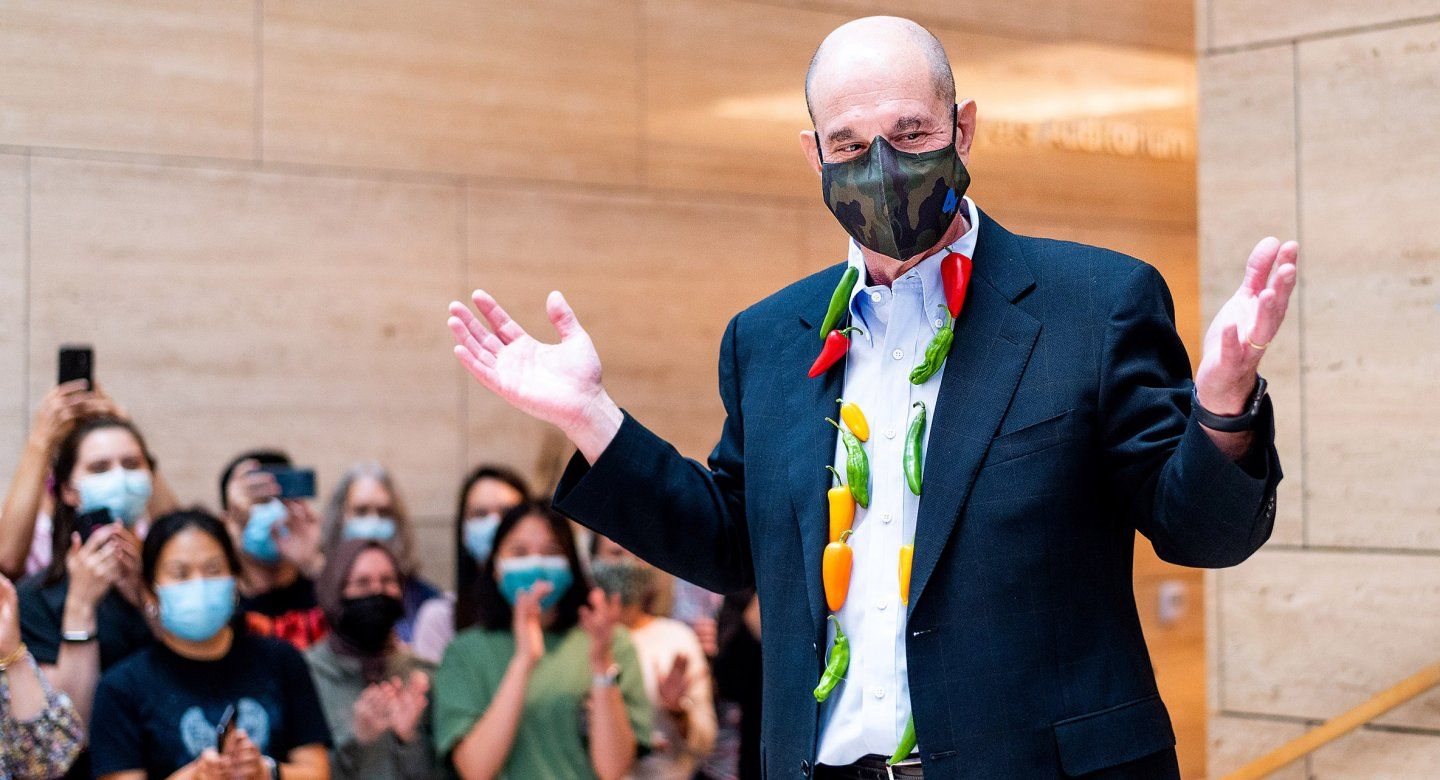UCSF Celebrates Its Newest Nobel Laureate David Julius
It was an alert at 2 a.m. that David Julius thought, at first, could be a prank.
But it was real: A relative was texting Julius to let him know that a man from Stockholm was asking for his phone number. That man turned out to be Thomas Perlman, the secretary-general of the Nobel Committee, trying to inform Julius that he had won the 2021 Nobel Prize in Physiology or Medicine.
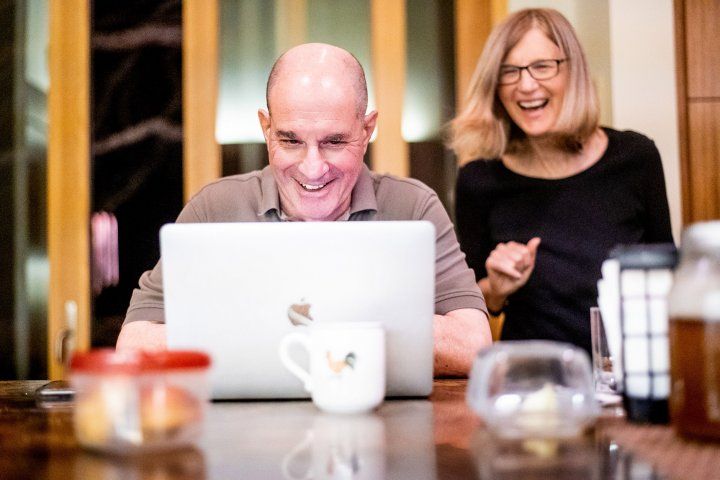
UCSF professor David Julius, PhD, and his wife, UCSF professor Holly Ingraham, PhD, field calls early Monday morning from their home in Walnut Creek after learning Julius was awarded the Nobel Prize in Physiology or Medicine. Photo by Noah Berger
Julius, PhD, professor and chair of the Department of Physiology and Morris Herzstein Chair in Molecular Biology and Medicine at UC San Francisco, was awarded the Nobel Prize with Ardem Patapoutian, PhD, a Scripps researcher, and a UCSF postdoctoral alum.
The two were awarded the Nobel Prize “for their discoveries of receptors for temperature and touch,” according to the Nobel committee in Stockholm, Sweden.
“It was really a shock – a blast out of nowhere and quite a thrill. And then stuff started happening very quickly,” Julius said during a Zoom tribute and champagne toast for the UCSF community with Chancellor Sam Hawgood, MBBS, and Talmadge E. King Jr., MD, dean of the School of Medicine.
Hawgood said that Julius epitomizes the very best of UCSF science, using his curiosity about the natural world to remarkable success. “He is passionate about the work he does, following his curiosity to understand the basic fundamental question of how do we feel pain and how do we react through sensation to the world around us.”
A Happy, Frenetic Day
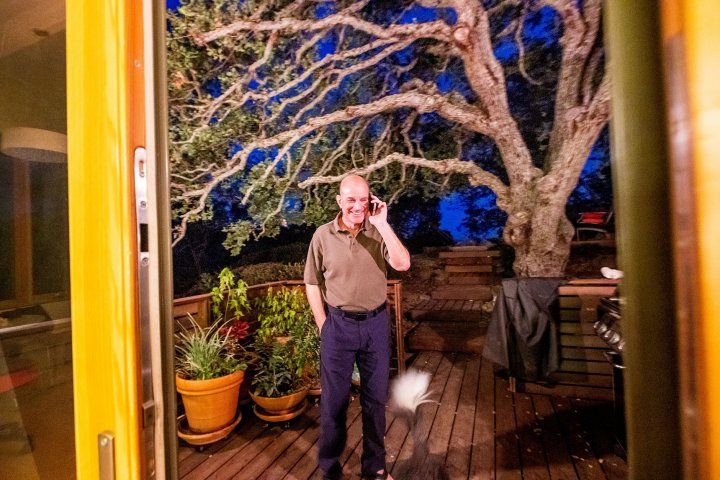
David Julius, PhD, fields a congratulatory call from a colleague after learning he was awarded the Nobel Prize in Physiology or Medicine on Monday, Oct. 4. The phone calls with media and others started well before dawn after the 2 a.m. announcement. Photo by Noah Berger
The Nobel news for Julius set off a frenzied day of phone calls with media as well as celebrations with his laboratory and the UCSF community.
After fielding interviews before sunrise from top media outlets around the world, then participating in a virtual press conference from his home in Walnut Creek, Julius drove to his lab at UCSF’s Mission Bay campus. He was quickly joined by congratulatory postdoc fellows and other colleagues.
“I guess our 11:45 am meeting is canceled today,” quipped Genentech Hall neighbor Ron Vale, PhD, professor of Cellular and Molecular Pharmacology.
Julius thanked his colleagues and lab mates, singling out lab manager Jeannie Poblete, whom he has worked with for 27 of the 30-odd years of his career at UCSF. Poblete, in turn, praised Julius for his work – and more. “This success is because of him being him – he is a very good boss. Not only is he a brilliant researcher, he is very compassionate and cares about your career and your family,” Poblete said.
Highlighting Importance of Basic Research
In remarks throughout the day, Julius emphasized the importance of collaboration with other faculty, staff and researchers, including those just starting out in their careers. In addition, he spoke about the importance of basic research – work that strives to understand the basic underpinnings of our physiology.
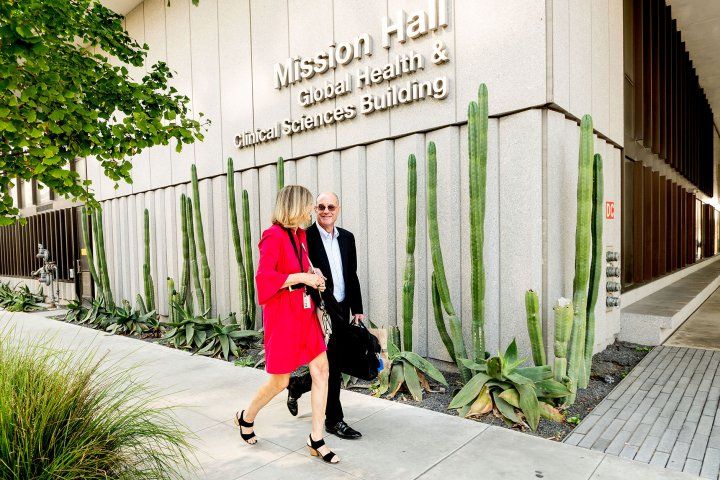
UCSF professor David Julius, PhD, and his wife, UCSF professor Holly Ingraham, PhD, arrive at the UCSF Mission Bay campus on Monday. Oct. 4. Photo by Noah Berger
“I think science is to some degree like real estate – location, location, location – and UCSF has been just such a fantastic place to work. We’ve had so many fantastic trainees, fellows, students and colleagues here, many of whom I’ve collaborated with. This environment is a large part of the success I have enjoyed. Being here has been a privilege and it is a thrill to represent UCSF today,” Julius said during the campus Zoom celebration.
Julius’s work also highlights the importance of continuing to fund basic “curiosity-driven” research that doesn’t have a specific therapeutic goal in mind at the outset—but which could eventually lead to therapies, he said.
“Most of the great advances in understanding mechanisms in medicine really start off by (scientists) following their curiosity without knowing in advance that they would be working on something that could one day be useful in therapeutics,” Julius said.
The discovery of bacterial mechanisms like CRISPR that underlie the ability to modify genomes (which won a Nobel Prize last year), as well as research on protease inhibitors that led to the development of treatment for people with HIV/AIDS, are just two examples of how allowing scientists to follow their natural curiosity can lead to groundbreaking innovations, he added.
“I’m so thankful that in this country we have public institutions like the National Institutes of Health and University of California system to provide funding to me, and other people like me, who are asking basic questions without knowing whether they are ‘useful’ or will be translational at some point,” Julius said.
From Chili Peppers to Painkillers
Julius’s work with capsaicin, the chemical compound responsible for the spicy “heat” of chili peppers, has elucidated how the nerve endings in our skin respond to heat. Since joining the UCSF faculty in 1989, Julius, along with students, postdoctoral fellows and other researchers in his lab, have sought to understand how neurotransmitters, drugs, and natural products regulate the nervous system. His work has offered insights into the molecular basis of pain sensation and potential targets for new forms of painkillers.
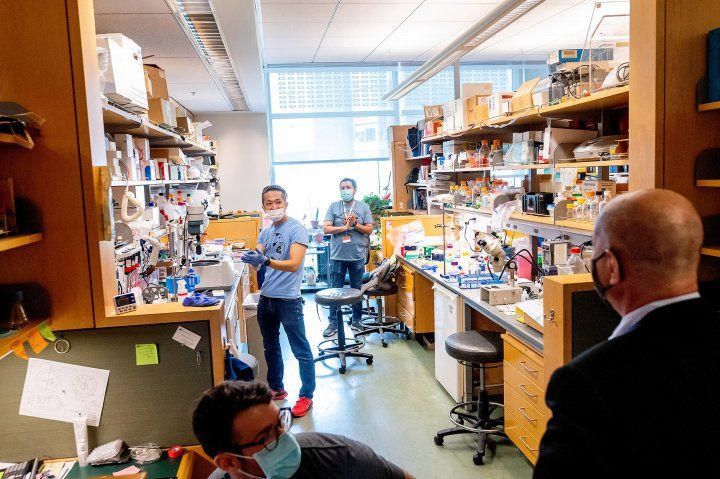
David Julius, PhD, arrives to applause in his lab at the UCSF Mission Bay campus. Photo by Noah Berger
“Over the years, David has talked about how his fundamental physiological research was motivated by what he saw as a dearth of therapies to treat one of the most common and debilitating medical conditions, which is pain. He has spearheaded some of the major advances in the field through his identification and characterization of the nerve cell ion channel receptors known as TRP receptors,” King said. “Today, with pharmaceutical companies targeting new pain therapies that target TRP receptors, David’s work has come full circle.”
Julius and his lab have taken advantage of a variety of noxious substances produced by animals and plants – including toxins from tarantulas and coral snakes; capsaicin; and the chemicals underlying the pungency of horseradish and wasabi, in order to understand how signals responsible for temperature and pain sensation are transmitted by neural circuits to the brain. Guided by studies of how these natural products and other compounds trigger sensations of heat, cold, and pain, Julius has homed in on a class of proteins called TRP (pronounced “trip”) ion channels as key players in the nervous system’s pain signaling apparatus.
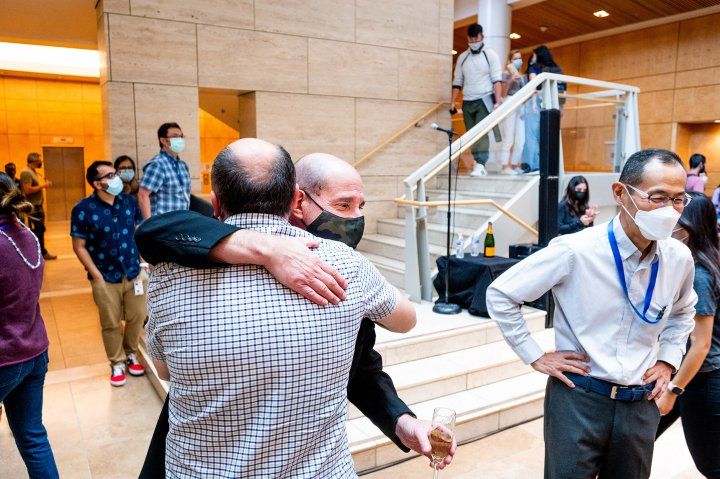
David Julius, PhD, hugs a colleague during a gathering in Genentech Hall to celebrating his Nobel Prize award on Monday, Oct. 4, 2021. At right is fellow UCSF Nobel laureate Shinya Yamanaka, MD, PhD. Photo by Noah Berger
Their work revealed that TRPV1, the ion channel responsible for the sensation of burning pain, responds both to capsaicin and temperatures greater than 110 degrees, both of which are transmitted to the brain as a sense of heat. TRPV1 also contributes to the hypersensitivity to heat felt in injured tissue, such as sunburned skin, where mild stimuli can be perceived by the brain as burning hot.
Julius and his team proceeded to identify other distinct TRP channels responsible for other types of sensation. His lab used menthol from mint and related compounds to identify a distinct channel called TRPM8 that responds to cold temperatures, and a third channel, TRPA1, that responds to the pungent compounds in wasabi, and is also involved in inflammatory pain.
In recent years, Julius and his lab have turned their attention to better understanding the structure of TRPV1 and related molecules, in hopes that this information could drive the design of new pain drugs. In 2013, he and UCSF colleague Yifan Cheng, PhD, used a technique called cryo-electron microscopy, or cryoEM, to determine the structure of TRPV1 at near-atomic scale. In 2015, Julius and Cheng used cryo-EM to determine the structure of TRPA1, the “wasabi receptor.”
Where the Magic Happens
The chili pepper – a source of inspiration for much of Julius’ ion channel research – was back in the limelight on Monday – as the backdrop for celebratory photos.
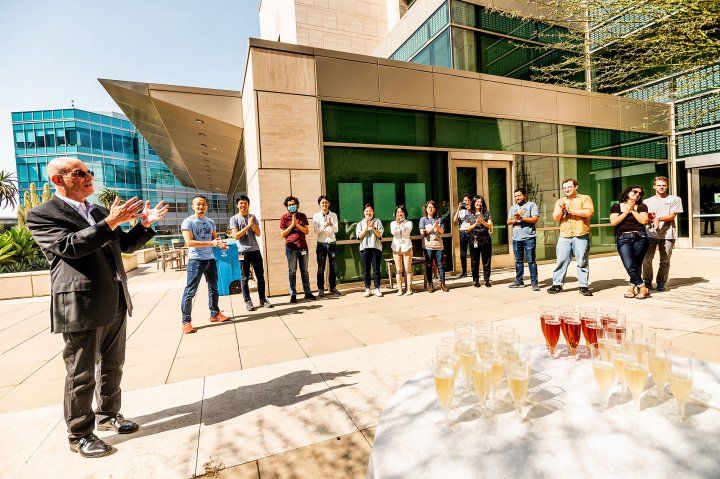
David Julius, PhD, celebrates with members of his lab on a patio in Genentech Hall after learning he was awarded a Nobel Prize on Monday, Oct. 4. Photo by Noah Berger
Shortly after noon, dozens of Julius’s colleagues at his and neighboring labs accompanied him and his wife, UCSF professor Holly A. Ingraham, PhD, to the roof deck for sunshine, champagne and fruit tarts. A table adorned with chili peppers and a molecular structure of a TRP receptor provided a festive backdrop for the many photos, speeches, and popping of corks.
Later, the party moved to the atrium of Genetech Hall, where Julius and Hawgood made short speeches at a gathering of faculty, staff and trainees – and Hawgood presented Julius with a garland of chili peppers to wear around his neck.
“It’s a brilliant day for UCSF,” Hawgood said.
